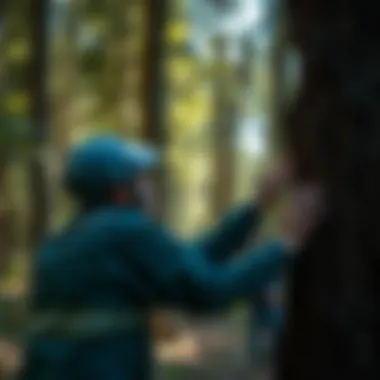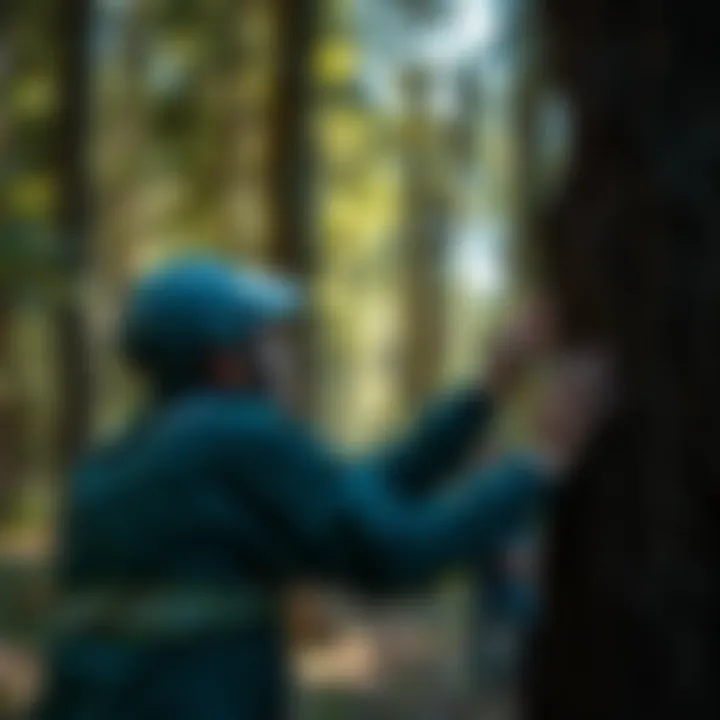Understanding Bark Safety in Forestry Practices


Intro
Forests are often viewed as the lungs of our planet, absorbing carbon dioxide and producing oxygen. Yet, beneath the surface of this lush, green canopy lies a complex world that requires our careful consideration. One critical aspect of maintaining healthy forest ecosystems is bark safety. Understanding the biological significance of tree bark, along with how it interacts with the overall health of the forest, is vital in forestry practices. From ensuring the vitality of flora and fauna to promoting biodiversity, the role of bark in the ecosystem cannot be overstated.
In this article, we’ll dive into the intricate dynamics of bark safety and its applications within sustainable forestry practices. We’ll explore how bark contributes to tree health and the broader implications of bark damage. Furthermore, we aim to emphasize the partnership between communities and forest stewards in maintaining these vital resources for years to come.
Forest Ecology and Biodiversity
Importance of Forest Ecosystems
Forests are not just collections of trees; they house a variety of organisms that depend on each other. They store significant amounts of carbon and support countless species, making them essential to global biodiversity. Tree bark serves as a protective layer for trees, shielding them from pests and diseases while providing habitat for various organisms. It acts as a barrier that prevents the entry of pathogens, and when healthy, it can contribute to a tree's longevity and functionality within these ecosystems.
The loss of bark integrity can have cascading effects within a forest. When bark suffers from damage, it can lead to a decline in tree health, creating gaps in canopies, and these gaps disrupt the light and moisture balance crucial for other woodland plants and animals.
Flora and Fauna in Woodlands
Woodlands are a vibrant mosaic of life where trees, plants, mammals, birds, insects, and microorganisms coexist. The health of bark directly affects flora and fauna in significant ways:
- Protection for Animals: Certain bird species rely on the bark as a nesting site, while small mammals often hide in its crevices.
- Food Source: The bark itself can provide sustenance. For example, many insects, such as bark beetles, depend on it for nourishment and habitat.
- Microbial Activity: Healthy bark sustains microbial populations, essential for nutrient cycling and soil health. Without these tiny powerhouses, the forest's productivity could diminish.
In understanding these relationships, forestry professionals can better appreciate why bark safety should be a priority in sustainable management practices.
"Healthy bark is the silent protector, shielding the tree and its community from the many challenges of a changing environment."
Sustainable Forestry Practices
Techniques for Responsible Management
To ensure the vitality of bark, specific techniques in forestry can minimize damage during operations. Here are several best practices:
- Use of Hand Tools: Where feasible, opt for hand tools over machinery to reduce bark impact.
- Avoiding Proximity: Maintain a safe distance from trees with significant cultural value. Avoid scraping the bark during harvesting or site preparation.
- Assess Equipment: Ensure that machinery and tools are equipped with protective measures to avoid bark injury.
By incorporating these techniques, the vitality of bark can be safeguarded, contributing to healthier trees and more resilient forests.
Certification Schemes and Standards
Engagement in certification schemes is another measure that forestry professionals can adopt. These schemes, like the Forest Stewardship Council and the Programme for the Endorsement of Forest Certification, advocate for sustainable practices. Adhering to these standards helps ensure that bark safety becomes an integral part of forest management strategies, promoting responsible stewardship across diverse landscapes.
Community Engagement and Stewardship
Role of Local Communities
Local communities play a crucial role in maintaining the health of forests. By partnering with professional forestry organizations, community members can aid in preserving and understanding bark safety. This collaborative approach can create awareness and project ownership among citizens, making them more invested in the condition of their local woodlands.
Volunteer Opportunities for Engagement
Engaging communities can take many forms. Volunteer programs that involve tree planting, bark assessments, and educational workshops are ways people can get involved. Organizations like the Arbor Day Foundation or local conservation groups often have programs suited to instill community appreciation and knowledge about bark safety and overall forest health.
In summary, understanding bark safety is not just a technical concern; it is a critical part of ensuring the integrity of our forest ecosystems. By integrating scientific knowledge about the role of bark with community efforts, we establish sustainable practices that benefit both the environment and society at large. This not only preserves the intricate web of life found within our forests but also lays the groundwork for future generations to enjoy the bounty of nature.
Prologue to Bark Safety
In recent years, the conversation surrounding forest management has evolved significantly, leading to an increased focus on the importance of bark safety. This article aims to unpack the layers of this essential aspect of forestry practices, exploring its implications not just for individual trees but for entire ecosystems. From the role bark plays in the life of a tree to the risks associated with its damage, understanding bark safety is crucial. This knowledge lays the groundwork for better management strategies that ensure both tree health and the well-being of the broader environment.
Defining Bark Safety
Bark safety can be defined as the measures taken to protect the bark of trees from any form of damage during forestry practices. It's not merely about preventing physical injury; it encompasses the health of trees, the vibrant ecosystems they support, and the larger environmental benefits they provide. Healthy bark acts as a protective barrier against disease and insect infestations, while also facilitating the tree's ability to manage water and nutrients.
Many people may underestimate the bark's role, often viewing it simply as the outer layer of a tree. However, it functions similarly to human skin—offering protection while also serving vital physiological functions. If the bark is compromised, the entire tree’s health is put at risk, as it can lead to severe consequences such as stunted growth or even tree mortality. Therefore, understanding and implementing bark safety should be considered a priority in modern forestry practices.
Importance of Bark in Trees
The bark of a tree is no less significant than the roots or leaves; in fact, it plays multifaceted roles that are integral to the tree’s survival. First and foremost, bark provides protection against pests and diseases. Think of it as a fortress—while it shields against external threats, it also helps maintain the internal ecosystem of the tree.
Additionally, bark helps in water and nutrient management. It regulates the flow of these essential resources, ensuring the tree remains nourished and healthy. Another often overlooked aspect is its role in temperature regulation. The bark acts as an insulation layer, helping to moderate the tree's internal temperature throughout varying weather conditions.
Therefore, neglecting bark safety not only endangers the tree but also impacts the complexity and vitality of the forest as a whole. Healthy trees contribute to biodiversity, sustain wildlife, and maintain soil quality—hence, ensuring bark safety is critical for environmental integrity and forest sustainability.


"Without proper care for bark, we jeopardize not just the individual tree's longevity, but also the entire ecosystem's delicate balance."
Understanding the significance of bark safety will shape the practices of forestry professionals, allowing them to foster healthier forests while adhering to best management practices. As we delve deeper into the subsequent sections, the layers of bark safety will become increasingly clearer, paving the way for more informed forestry practices.
The Biological Functions of Bark
Bark serves as the tree's first line of defense, a protective barrier that plays multifaceted roles critical to the health and survival of trees. Understanding how bark functions goes beyond aesthetics; it reveals how vital this outer layer is to a tree's well-being and, by extension, the health of the entire forest ecosystem. By analyzing the biological functions of bark, we can appreciate the intricate balance of nature and how bark safety can impact broader forestry practices. In this section, we will explore bark's protective mechanisms against pests and diseases, its role in water and nutrient management, and its function in insulation and temperature regulation.
Protection Against Pests and Diseases
Bark is not merely a static shield; it’s a dynamic protector. The external layers can deter various pests like beetles and caterpillars that threaten a tree's integrity. Bark's thickness and toughness serve as physical barriers; however, it also produces chemical compounds that repel or inhibit pest activity.
Furthermore, some trees possess bark that can regenerate quickly after being damaged, which can restore that protective barrier if breached.
- Physical Protection: The outermost layer is often rough and tough, making it difficult for insects to penetrate.
- Chemical Defense: Trees may release toxins that are unpalatable to predators, thereby reducing the likelihood of infestation.
"A tree's bark acts as its armor, fending off adversaries just the way a knight would in battle."
Understanding these defensive strategies is vital for forestry professionals. If bark is damaged, this protective function diminishes, allowing pests and diseases to enter, which leads to more extensive problems in the forest.
Water and Nutrient Management
Bark plays a role in regulating moisture and nutrient transport within a tree. It is involved in the transportation of essential nutrients and acts as a reservoir that stores water. When conditions become harsh, trees can draw upon these reserves, ensuring their survival during dry spells.
- Water Regulation: Bark minimizes water loss through transpiration, which is essential for maintaining moisture levels within the tree.
- Nutrient Transport: The inner bark layer, known as cambium, is actively involved in transporting organic nutrients throughout the tree, feeding its various systems.
Understanding how bark facilitates efficient water and nutrient management can inform practices that aim to preserve this crucial layer. Damaged bark may disrupt these processes, negatively impacting the tree's health and the surrounding ecosystem.
Insulation and Temperature Regulation
Temperature fluctuations can be harsh for trees, but bark acts as an insulator, providing a buffer against extreme weather conditions. In colder climates, bark protects the living tissues within from freezing temperatures, while in hot weather, it prevents overheating.
- Thermal Protection: The insulating properties of bark help maintain a stable internal temperature, crucial for metabolic activities.
- Microclimate Regulation: Bark contributes to creating a microenvironment around the tree, which assists in promoting beneficial organisms around the base and in the canopy.
This insulation is not just a luxury; it is a necessity for a tree's physiological processes. Damage to bark can leave trees vulnerable to temperature extremes, which could risk their survival and that of other organisms relying on them.
As we see, the biological functions of bark extend far beyond mere aesthetics. They are integral to the tree's health and have profound implications for forest ecosystems. To maintain a thriving forest, understanding and protecting these unique functions is essential.
Common Causes of Bark Damage
Understanding the common causes of bark damage is crucial for forestry professionals and naturalists alike. Bark not only protects trees but serves vital ecological roles. Damage to bark can therefore jeopardize tree health, which in turn affects entire forest ecosystems.
Mechanical Injury during Logging
During logging operations, mechanical injury represents a significant risk to bark integrity. Heavy machinery, like harvesters and skidders, can easily inflict wounds on the bark during operation. When a tree suffers a gouge or a scrape, the vulnerability increases to pathogens and pests, compromising its overall health. An unintentional strike by a chainsaw can lead to deep cuts that allow moisture to seep in, resulting in decay.
To mitigate this risk, logger training is essential. Operators must learn precision handling of equipment and the importance of situational awareness. Implementing careful maneuvering and ensuring safe distances between machinery and trees can minimize bark damage.
"Preserving bark integrity ensures that trees not only survive but thrive in their environment."
Environmental Factors
Tree bark is also susceptible to damage from environmental factors. These can include severe weather conditions like storms, hail, or extreme temperatures. When trees experience stress from drought or excessive moisture, the bark can become weak. This weakens the tree's defenses against pests and diseases, creating a vicious cycle of degradation.
Many professionals overlook the impact of human-induced factors such as pollution and habitat fragmentation. Trees in urban or industrial areas might suffer from bark blistering or flaking due to exposure to harmful chemicals and particulates. Protecting forests from such threats requires collaboration between conservationists, municipalities, and policymakers to address pollution sources and enforce environmental regulations.
Pest Infestations
Pest infestations present another critical avenue of bark damage. Insects like the emerald ash borer or bark beetles can bore into the bark, causing extensive damage. The infestation often remains unnoticed until it's too late. The presence of these pests not only destroys bark but can lead to tree mortality in severe cases.
Integrated pest management (IPM) strategies can be beneficial in curbing the impacts of pests on tree bark. Following practices that monitor pest behavior and employing natural predators or biological controls can help manage pest populations. Additionally, keeping trees healthy through proper care and maintenance can bolster their defenses against such infestations.
By understanding and addressing these common causes of bark damage, forestry professionals can make informed decisions that protect both individual trees and broader forest ecosystems. Collective efforts in knowledge sharing and applying best practices are key to ensuring sustainable forestry operations.
Assessing Bark Health
Assessing bark health is crucial in forestry as bark serves as the protective layer of trees. A thorough assessment not only safeguards the vitality of individual trees but also ensures the overall health and sustainability of entire forest ecosystems. Without proper evaluation of bark conditions, significant issues could arise, leading to compromised tree health, reduced growth rates, and even increased susceptibility to pests and diseases. Therefore, understanding how to effectively assess bark health becomes an essential skill in modern forestry practices.


Visual Inspection Techniques
Visual inspection techniques are the first line of defense in assessing bark health. This method is straightforward and does not require sophisticated technology. Forestry professionals often rely on their eyes to spot symptoms that indicate bark issues. Key indicators include signs of peeling, discoloration, or the presence of wounds. A simple look at the tree can reveal a lot about its health. For instance, if you notice unusual cracking or sap leaks, these might indicate problems lurking beneath the surface.
Additionally, visual assessments can help in identifying patterns of damage associated with specific pests or diseases. Recognizing these signs early allows for timely intervention, potentially saving the tree and preventing further disruption to its surrounding environment. It’s not just about what you see; it’s about piecing together the narrative the bark is telling you.
Using Technology for Assessment
In contemporary forestry, technology plays a pivotal role in assessing bark health. Innovations such as remote sensing and drones have become popular tools. These technologies offer insights that go beyond what a simple visual inspection can provide.
Remote Sensing Technologies
Remote sensing technologies have redefined how we approach bark assessment. These techniques involve the use of aerial sensors to capture data about tree canopies and bark conditions on a large scale. The key characteristic of remote sensing is its ability to gather data without direct contact, making it a non-invasive technique.
One significant advantage is efficiency; it allows for vast forest areas to be surveyed in a fraction of the time it would take with traditional methods. However, interpreting the data can sometimes require expertise or specialized training.
This capability makes remote sensing an increasingly popular choice for forest management, as it provides an overview of tree health that can be crucial for early intervention.
Nevertheless, one major drawback might be the initial cost of implementation and the need for ongoing technical support. Despite these challenges, the long-term benefits often outweigh the short-term hurdles.
Drones in Forest Assessments
Drones are gaining traction in the forestry sector, primarily due to their ability to access hard-to-reach areas and gather real-time data. The key trait of drones is their maneuverability, which allows them to navigate complex terrains with ease. They can capture high-resolution images and provide precise mapping information that assists in understanding bark conditions more deeply.
Unlike remote sensing from satellites, drones deliver immediate results, which is particularly valuable for dynamic environments where conditions may change rapidly. However, challenges exist, such as regulatory restrictions in certain areas and the need for skilled operators to manage the technology effectively.
Overall, drones have become a popular choice for bark assessments, offering quick assessments and timely data collection, but they still require a hands-on approach to translate that data into actionable insights.
Indicators of Bark Health
Recognizing indicators of bark health is essential in forestry. A variety of signs often reveal the condition of bark, including:
- Thickness of bark
- Presence of lesions or cracks
- Signs of fungal growth
- Variations in color
- Any abnormal excretions, such as sap flows
These indicators act as red flags for the forester, signaling whether a tree is thriving or struggling. Proper understanding and monitoring of these signs allow proactive measures to be implemented, ensuring not just the survival of individual trees but the resilience of the entire forest ecosystem.
Best Practices for Bark Protection
Protecting the bark of trees is a critical responsibility in forestry, as bark safety not only preserves tree health but also fosters the broader health of forest ecosystems. By implementing best practices for bark protection, foresters can minimize damage during operations, ensuring both sustainable forestry practices and the longevity of trees. Proper bark protection directly influences the growth of trees, their resilience to pests, and the overall biodiversity of the ecosystem. Consequently, understanding these practices is crucial to striking a balance between forest utilization and conservation.
Implementation of Careful Logging Techniques
When it comes to logging, the techniques employed can make or break the health of a tree’s bark. Careful logging, as the name suggests, requires awareness and skill. One foundational approach is to limit the use of machinery around trees; a careless bump or scrape can result in long-lasting damage. Instead, using methods like direction felling, or planned cutting, ensures that trees are removed without impacting their neighbors.
Additionally, planning the routes for equipment can minimize accidental bark scraping. When logging in clear-cut areas, creating designated pathways for machines allows workers to operate efficiently while protecting surrounding trees. Considerations such as seasonality also play a role—logging during dry seasons generally reduces soil compaction and damage risks. Thus, ensuring that logging teams are well-versed in these careful techniques is essential for safeguarding bark.
Trimming and Maintenance Practices
Keeping a keen eye on the existing trees is another key aspect of bark protection. Regular trimming can remove dead branches that might threaten tree bark's integrity. When trimming, maintaining a clean cut is vital; jagged edges can lead to wounds that make trees susceptible to pests and diseases. Furthermore, ensuring that cuts are made at the proper angle supports healthy regrowth and reduces the risk of damage to the bark.
Another important practice is to avoid excess trimming, commonly known as "topping.” This can severely impact a tree’s health, leading to bark damage and tree decline. Instead, encouraging an appropriate growth form through selective pruning helps maintain both the health of the bark and the tree overall. By putting these simple maintenance practices into place, foresters can significantly contribute to the protection of tree bark.
Establishing Protective Zones
Establishing protective zones around tree stands is a proactive strategy that can drastically reduce the risk of bark damage. These zones can act as buffers against various threats, including heavy machinery and nearby construction activities. By delineating areas that are off-limits to equipment, foresters can preserve vital trees and their bark.
Creating these zones doesn’t have to be complicated. Marking trees with flags or paint can easily communicate restricted areas to workers. Furthermore, public awareness campaigns surrounding the importance of these zones can be conducted within forestry operations. When the community understands the reasoning behind such practices, the support of local stakeholders can be harnessed, ensuring even broader compliance in maintaining bark safety.
Key Takeaway: Establishing protective zones not only safeguards bark but ensures the health of ecosystems for generations ahead. By implementing thoughtful logging techniques, maintaining and trimming trees effectively, and clearly defining protective areas, forestry practices can achieve a harmonious balance with nature.
Impact of Bark Damage on Forest Ecosystems
Bark damage can have far-reaching consequences, not just for individual trees, but for the entire forest ecosystem. When we talk about the implications of this damage, we must consider the health of the trees, their capacity to grow, and how this intertwines with the wellbeing of biodiversity within these environments. It’s essential to grasp how disrupted bark can compromise not only arboreal giants but also the myriad species that call these forests home.
Effects on Tree Health and Growth
Tree health is fundamental to a thriving forest. When bark is injured, the tree faces numerous challenges, ranging from stress and vulnerability to diseases to disrupted nutrient transportation. The bark serves as a crucial barrier, acting like a second skin to protect the inner tissues of the tree. Damage can expose those delicate layers to pathogens, pests, and adverse environmental conditions.


For example, consider the formal structure of a tree, its growth rings, which reveal decades of history. If bark is stripped away due to pests like the mountain pine beetle or environmental stressors like wildfire, these rings can become malformed, leading to abnormal growth patterns. This not only affects the individual tree's health but also its ability to reproduce. Weak trees often yield fewer seeds, further reducing regeneration potential across the forest.
Recent studies have shown that trees suffering from bark damage can exhibit a decrease of up to 60% in growth rate, underscoring the importance of maintaining bark integrity in managing forests.
Implications for Biodiversity
Turning toward biodiversity, the knock-on effects of bark damage are profound. A healthy tree canopy provides habitat and food for countless organisms, from insects and birds to mammals. When bark gets damaged, it can lead to a domino effect on these species. Many animals rely on the bark for shelter or food sources; hence, a decline in bark health can result in diminished habitats.
In particular, the loss of bark can increase exposure to sunlight, affecting underbrush growth. This adjustment in vegetation can change the entire dynamics of an ecosystem, impacting everything from the smallest microbes in the soil to larger fauna navigating through the forest. Here are a few specific considerations:
- Insect Populations: With the bark compromised, trees may become more susceptible to invasive insects, leading to declines in native species and altering ecological balance.
- Plant Communities: Altered light conditions can shift competitive dynamics between plant species, promoting certain plants while choking out others, leading to homogenization of plant communities.
- Nutrient Cycling: Bark damage can inhibit the tree's ability to perform photosynthesis, thus affecting the carbon cycle and nutrient availability within the ecosystem.
Addressing Bark Safety in Forestry Policies
Addressing bark safety within forestry policies is not just a legal requirement; it is a fundamental aspect of sustainable forest management. The interplay between legislative frameworks and the health of tree ecosystems is critical. It provides guidance on how to protect bark, the layer that serves as a barrier against biological threats and environmental stressors. Proper regulation can enhance forest resilience, ensuring that trees remain healthy and capable of supporting biodiversity.
Integrating bark safety into existing policies offers multiple benefits. First, it helps define best practices for logging operations, setting a standard that minimizes damage. When loggers are educated on how to handle trees with care, not only does it safeguard the bark, but it also enhances the overall health of the forest.
Another point of consideration is the long-term sustainability of tree populations. Policymakers must understand that any decision affecting bark can ripple through the entire ecosystem. Healthy bark means healthier trees, which in turn leads to a supportive habitat for various species. Essentially, this becomes a win-win situation for both the forest and the communities that rely on it.
In developing robust policies, stakeholders should consider the following elements:
- Current Research and Data: Regularly update regulations based on the latest studies regarding bark health and tree biology.
- Stakeholder Consultation: Involve forest workers, ecologists, and community members in the drafting process to ensure a balanced perspective.
- Monitoring and Enforcement: Establish clear monitoring protocols and enforcement mechanisms to ensure compliance with bark safety standards.
Policies that neglect the importance of bark safety risk undermining forest ecosystems and the benefits they provide. Bark may seem like an insignificant part of a tree, but its role is crucial; it protects the cambium and the tree's vascular system from harmful elements. Thus, addressing bark safety propaagates practices that enhance both ecological and societal outcomes.
"Healthy trees grow stronger and provide more to the environment; when your bark is in good shape, it’s not just the tree that flourishes, but the whole ecosystem thrives."
Assessing how bark safety fits into wider forestry regulations emphasizes its significance, potentially leading to substantial improvements in both tree and forest health. As policies evolve to incorporate these considerations, they will play a vital role in safeguarding the future of our forests.
The Future of Bark Safety in Forestry
The landscape of forestry is not static; it evolves continuously, driven by advancements in technology, shifts in environmental priorities, and changes in policies. As we gaze into the horizon of bark safety, it becomes evident that future practices will hinge on innovative research and informed policy-making. Understanding these elements is crucial for forestry professionals and academics alike, as it directly impacts sustainable forest management and conservation.
Innovative Research and Developments
The agricultural and forestry sectors have seen a wealth of ongoing research focused on enhancing bark safety and resilience against various threats. Significant strides in our understanding of tree physiology and bark function are paving the way for the development of better management strategies. Some key areas of innovative research include:
- Genetic Studies: Researchers are exploring the genetic basis of bark thickness and resilience to pests. By identifying specific genes that confer protective traits, it may become possible to selectively breed trees that exhibit enhanced bark features.
- Biocontrol Methods: The shift towards sustainable pest management includes leveraging natural predators and biopesticides instead of chemical treatments. Examination into the interaction between tree bark and beneficial microorganisms is revealing opportunities for fostering healthier trees naturally.
- Material Science: Understanding how bark responds to different environmental stressors is being translated into more effective treatments and protective measures. Studies are being conducted on how synthetic materials can imitate bark properties to protect against mechanical damage in logging operations.
These research endeavors not only highlight ingenuity but also underscore the importance of integrating scientific findings into practical applications. As new techniques and methodologies emerge, forestry practices can change to mitigate risks associated with bark damage and disease, ultimately leading to more robust forest ecosystems.
Potential Policy Changes
Policy frameworks related to forestry need to be proactive, addressing not just current challenges but anticipating future risks as well. As bark safety becomes a more prominent concern, various potential policy changes might come into play:
- Enhanced Regulations: Strengthening regulations around logging practices to incorporate best practices for minimizing bark damage is essential. Establishing standards for equipment used in logging operations can ensure that bark integrity is preserved as much as possible.
- Educational Guidelines: Developing educational initiatives that keep forestry workers informed about the importance of bark and its role in tree health is critical. Training sessions that emphasize the ecological functions of bark may inspire more conscientious behaviors in the field.
- Collaboration with Conservation Groups: Building partnerships between forestry agencies and environmental organizations can aid in creating holistic approaches to bark safety. Joint efforts might include collaborative research projects that address bark health on a landscape level.
By taking actionable steps through policy changes, we can secure the future of our forests for generations to come, balancing economic needs with ecological integrity.
The integration of innovative research and potential policy shifts presents a promising avenue toward reevaluating bark safety standards in forestry. As we move forward, it’s vital to foster a culture of learning, adaptation, and accountability to ensure that the crucial protective layer of trees remains intact in the face of whatever challenges lie ahead.
Finale
The significance of bark safety in forestry practices cannot be overstated. It is pivotal for maintaining the delicate balance within forest ecosystems while supporting sustainable management methods that benefit both nature and human communities. When we reflect on the variety of topics covered throughout this article, the multifaceted role of bark emerges as a keystone in tree health and ecological stability.
Summarizing Key Points
In summation, here are critical insights that stand out:
- Definition and Importance: Bark safety encompasses the protective qualities of tree bark, which guards against pests and environmental stressors. Understanding this concept is essential for forestry management.
- Biological Functions: Bark serves various functions, including moisture regulation and thermal insulation. Recognizing these roles helps in comprehending why preserving the integrity of bark is vital.
- Impact of Damage: We learned that bark damage can lead to significant repercussions, not only for individual trees but also for the entire ecosystem. This ripple effect underscores the importance of preventive measures.
- Assessment Techniques: As discussed, implementing effective evaluation methods, like visual inspections or technological assessments, is crucial in determining bark health and ensuring its preservation.
- Best Practices: Adhering to efficient logging practices, maintenance routines, and establishing protective zones can significantly minimize the risks of bark damage.
- Policy Integration: Finally, advocating for the integration of bark safety into forestry policies lays the groundwork for long-term ecosystem support, leading us towards sustainable forestry practices.
Call for Continued Awareness and Action
It is imperative that we continue to raise awareness around bark safety and its impacts. This involves not just professionals in the field but also local communities and stakeholders who interact with the forests. Engaging with educational initiatives can facilitate a deeper understanding, enabling individuals to appreciate the essential role that bark performs in forest health and vitality.
Moreover, the landscape of forestry is subject to constant change due to myriad factors, including climate shift and increased human activity. Therefore, proactive measures must be taken to adapt practices and policies to these changes.
By fostering a culture of mindfulness and respect for bark safety, we promote healthier forests that can thrive for generations. Taking action today ensures that we are not only safeguarding tree health but also enhancing biodiversity and contributing to the overall ecological well-being.
"The health of any forest is intricately tied to the vitality of its trees; thus, the preservation of bark safety is not merely a concern for forestry but a call to protect our planet."
Addressing these issues takes collective effort, insights from innovative research, practical applications, and policy changes that promote sustainable practices. In the end, the fate of our forests largely depends on the conscious actions we take today.















